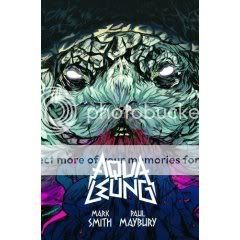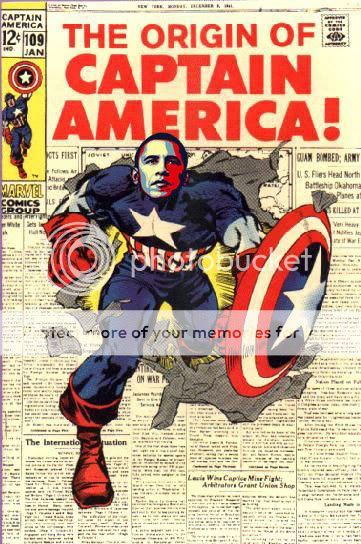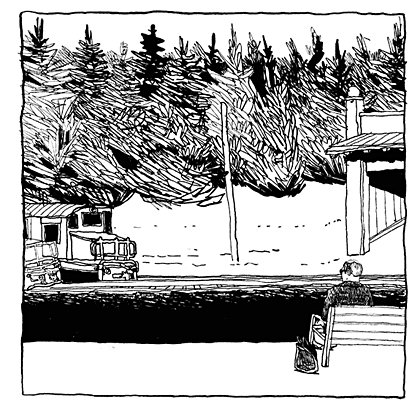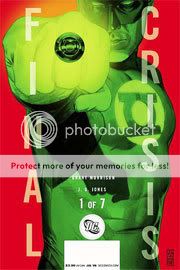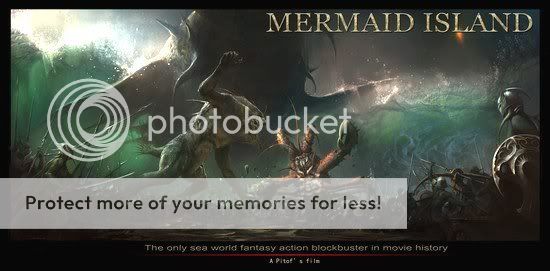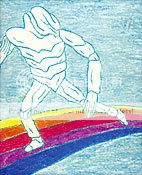Paradise Kiss Vols. 1-5
Ai Yazawa, writer/artist
Tokyopop, 2002-2004
Approx. 180 pages each
$9.99 each
Originally written on September 28th, 2004 for publication in The Comics Journal
I never really understood the notion of style (as opposed to fashion) until the lead singer of the Dandy Warhols explained it to me. Courtney Taylor-Taylor, the ectomorphic frontman for the Portland-based purveyors of retro-decadent glam pop, told me during an interview that style is merely the outward manifestation of a person’s insides. “How should my clothes fit and how should my hair look [is determined by] which look for me will better represent, at first glance, what I am about,” he said. (A fringe benefit, he later added, was that this acted as a filter against meeting people who don’t already like you, so you end up involved in fewer dead-end conversations.)
Coming as it did at a point in my life where I was in the throes of an obsession with David Bowie, Roxy Music, Velvet Goldmine, and the entire glitter aesthetic (one which continues to this day), Taylor-Taylor’s words were a revelation to me. Though a combination of poverty and laziness has kept me from perfecting the type of personality-in-wardrobe-form the rock star was advocating, I continue to applaud those with the creativity and willpower to make a go of it.
It’s undoubtedly this reverence for style, combined with a comics fan’s appreciation for a unique story well told, a singular artistic sensibility, and stories about and for teenagers that condescend to neither character nor reader, that leads me to dig Paradise Kiss. Published by manga giant Tokyopop and prepared for the English-language audience by a bevy of translators and adaptors, Parakiss (to crib a familiar abbreviation the characters themselves use when referring to both the clothing design studio around which the comic centers and, in regular breakings of the fourth wall, the comic itself) is a pip of a series, five volumes of angst, lust, and fabulous, fabulous clothes.
Yazawa’s art serves as a wonderful descriptor of all three. Fans of the McCloudian notion that art and story are indistinguishable in comics will find much to love here, since (to these relatively inexperienced eyes) the graphic conventions of shoujo manga (the razor-thin line against acres of white backgrounds, the effete, wire-thin figures, even the riot of pseudo-dialogue and untranslated sound effects peppered throughout translated works) are for once harnessed to a story that makes sense out of them. When studious and beautiful prep-schooler Yukari gets drawn into the world of four students at a high school for the arts, Yazawa’s intricate and ornate draftsmanship does effective double duty, skillfully capturing not only the sensuous and emotional confusion our heroine feels as her world changes, but the gorgeous, Velvet Goldmine-quoting boy (George) who seduces her, and the exquisite, anachronistic clothes he designs.
Those clothes are a highlight, undoubtedly; I found myself looking forward to each chapter’s title page, since those pages boast pin-up images of Yukari (“Caroline,” to her Anglophilic new friends) and the rest of the crew in painstakingly drawn couture. Such moments also pop up in the narrative as well, as during the climactic fashion show, which is lovely enough from both a graphic and storytelling point of view that it ably bears the four volumes’ worth of weight placed upon it. In all cases it’s evidence that the apparent frivolity of Yazawa’s art is icing on a cake that’s not just substantive, but no less delicious for it.
The same can be said of her writing. We’re largely in teen soap territory here, but that’s undercut with a surprising deftness in characterization, brutal at times (George’s attention-starved ex-model mother, George himself in his egocentricity and sexual predation) and unexpectedly warm at others (gruff punk Arashi’s unechoed concern at the way Yukari is ditching her previous life more or less on a whim, young George’s gift to his budding drag-queen friend Isabella). There’s also a sexual frankness that’s quite refreshing: Sex is treated neither as an idealized pathway to spiritual perfection nor as a sweaty and sordid means of disease transmission, but as something that can be a great deal of fun and, therefore, a great deal of trouble. When Yukari walks in on her new friends Miwako and Arashi fucking on a pool table because neither of them has any privacy in their bedrooms, early in the first volume, I’m sure I’m not the only reader who thought “yep, that’s about right.” (The fact that the scenes are so opulently drawn reminds us, to paraphrase Trainspotting, that if it weren’t so pleasurable we wouldn’t do it.)
If anything, it’s this fidelity to the actual experience of teenage sexuality and gender issues that can be off-putting. At no point does Yukari (or Miwako), seem to think of her own pleasure as paramount when it comes to sex; the act is typically initiated either through pressure (in one alluded-to incident, physical) or as a surefire way to change a painful subject, and is always seen through the lens of the boy involved–how it makes him feel, about the relationship, about her; how she feels about the relationship, about him. Of course, I’ve seen little evidence that this unfortunate state of sexual affairs for Yukari is not indicative of how nearly all teenage girls are conditioned to view sex, so perhaps Yazawa is to be applauded for telling it like it is rather than chided for not setting a better example. Ditto her portrayal of Yukari’s entrée into the world of professional modeling–the poor girl is chided on several occasions to stop eating so much, a scene that will make the eating disordered in the book’s audience either cringe in horror or chuckle in recognition. (Speaking of that audience, how cool is it to read a comic book that assumes its reader is a girl? And one in which beautiful male characters are paraded around as eye candy and objects of the gaze?) Moreover, high school may suck, and we all wanted to escape from it, but if you’re a girl looking for freedom from conformity, stricture and misogyny, the fashion industry is not exactly a place I’d advise you to run to. Then again, all the characters seem to gain some awareness of this art-cum-industry’s faults, particularly in the book’s unusually nuanced epilogue, so it’s not like Parakiss is peddling the same line of bullshit as Cosmopolitan.
In other words, Paradise Kiss is about style, not fashion, despite its industry trappings (and despite appearing in serialized format in a Japanese fashion magazine). For George, Yukari, and the rest of the Paradise Kiss studio, the clothes are never about riding the crest of a trend or obeying external expectations–despite the fact that their success as designers (and as people) would be far more likely if that were the case. The clothes are about representing, at first glance, what they as young men and women (and drag queens) are all about. A bunch of precocious, horny, fucked-up 17-year-olds may not know what they’re all about, of course, but maybe that’s what makes their sense of style, and this manga, so enthralling.






